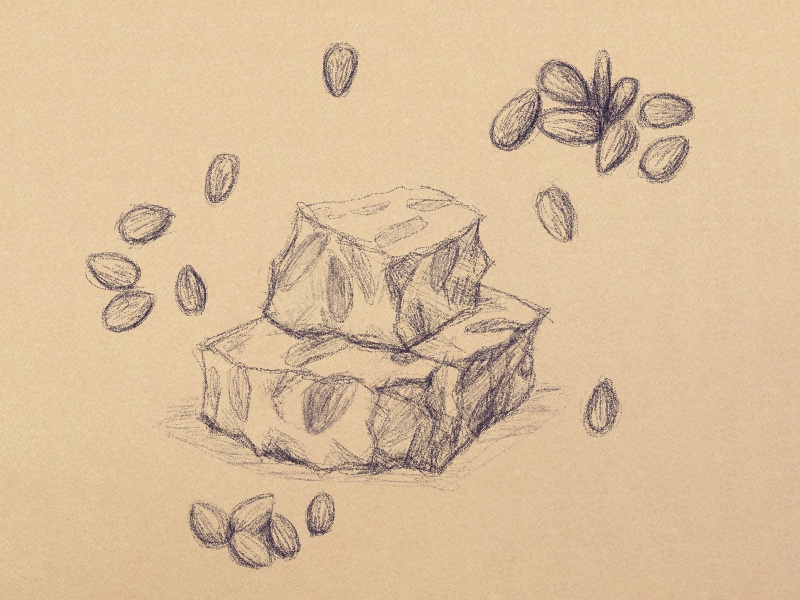By: Lalla Maiga
Protected Geographical Indications (PGIs) were introduced by the European Union (EU) to protect the names of products with a specific quality relating to where and how they are made. Examples range from Champagne from the Champagne region of France to Tequila from Mexico. In the same vein, manufacturers of turrón, a honey and almond-based dessert mainly consumed during the Christmas season, use the PGI label of ‘turrón de Alicante PGI’ and ‘turrón de Jijona PGI,’ which indicates the almonds used in the dessert must originate from the south-eastern town of Jijona or the Alicante province in Spain.

Credits: Illustration by Kit Chokly.
At the virtual Food Matters and Materialities conference, Emily Reisman, an Assistant Professor at the University of Buffalo, discussed the case of turrón. She explained how PGIs have become destructive to the local traditional producers of almonds in Spain with the introduction of California’s industrialized almond production in the global manufacturing of turrón.
So, what is the purpose of a PGI? The reason is to recognize and preserve the geographical origin of a product based on traditions of producing the specific product. A product can receive a PGI when the conditions of the territory and the methods of production are respected. Classifying a product as a PGI is significant because it recognizes the historical farming practices and preserves the values of production. The designation helps prevent forgeries and imitators in the international market. For the product of turrón, the PGI label guarantees authenticity to consumers to preserve the traditional recipe. The protection of turrón was due to turrón makers fearing their product would become generic on the global market and wanted specific protection for turrón produced in both Jijona and Alicante.
Traditionally, almond farming in Spain is conducted on small plots of land with no irrigation and sparse application of pesticides. Almond trees do not require much water, and they thrive in dry climates, making Spain’s dry summers and infrequent rainfall the perfect environment for growing almond trees. The combination of these conditions results in variable yields year to year for Spanish farmers. Farmers traditionally harvest almonds by hand which is labour intensive, however younger generations are migrating into urban centres which only reduces the labour available for farming. A rival to Spain’s almond production is California’s almond industry, characterized by Reisman as California-style almond production. The California-style almond production is characterized by industrialized farming, irrigation, and plantation-style labour. Given this more massive, industrialized scale of production, California yields for almonds are much higher than Spanish ones.
Central to Reisman’s critical discussion of PGIs was the fatal blow that occurred to the local production of almonds in Spain in 2011. The manufacturers of turrón requested a change in regulation to allow the use of imported almonds, mainly from California. The first reason for this was because turrón manufacturers identified that Spanish almonds were not absolutely necessary to producing turrón. The second reason was that California yields were guaranteed to produce a bitter-free almond. Spanish almonds are known to produce a bitter almond known to ‘tingle’ the tongue about 25% of the time, which is less tolerable and unappetizing to the taste buds of international consumers. This change in regulation to allow imported almonds excluded the input of local Spanish farmers who contributed to the production of turrón. Reisman discovered that farmers in Jijona were frustrated that a product their region was known for had been betrayed by the promise of PGIs to safeguard Jijona as a traditional producer of almonds for turrón, and turrón manufacturers who prefer the uniform, predictable California almonds.
Reisman’s concluding reflections affirmed that the uprooting of the turrón industry shows a tension present in rewarding industrial innovation rather than the local farmers complying with practices and methods belonging to their traditions of almond production. While PGI’s can be an exceptional legal mechanism to preserve and protect traditional products, it is also important to pay attention to what impact the significant flaws of a regulated tool may have on traditional local producers, as seen in the case study of turrón.